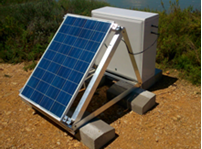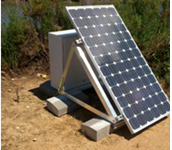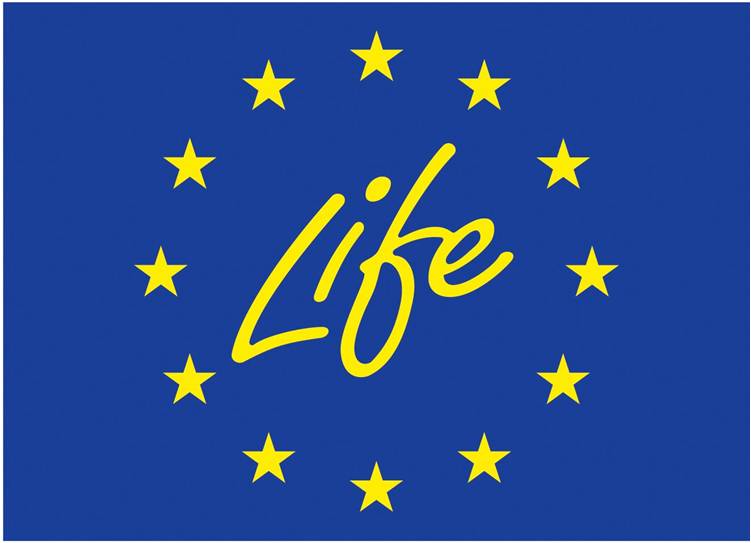Action B1: Demonstration of the possibility of energy optimization and renewable energy use
Action B1: DEMOSTRATION OF THE POSSIBILITY OF ENERGY OPTIMIZATION AND RENEWABLE ENERGY USE
This action is intended on the one hand to optimize the energy consumption of the installation by applying best practices of use and handling, and review of critical points of energy consumption of the facility and on the other to demonstrate the opportunity of using renewable energy sources to make energy balance of industrial aquaculture sustainable.
It also aims to obtain generalizable results to other aquaculture plants with similar characteristics, where the use of renewable energy allows to improve the sustainability of these activities, respecting the natural environment and mitigating emissions of greenhouse gases, thus reducing the carbon footprint of this productive activity. To get this energy sustainability tested in a real case, a hybrid system of electric power generation from renewable sources will be installed from a photovoltaic generator and a smallwind vertical axis generator, for connection to the power grid on a self consumption regime.
As a complement to make the energy balance more sustainable, in this activity it is proposed to use a pilot installation for the production of hot water through solar energy to provide heat, aditionally to the boiler proposed, to acclimatize the culture water for fry using a sustainable energy supply to reduce emissions of greenhouse gases, providing solar thermal energy of low temperature.
For the development of this activity four tasks are proposed:
![]()
B.1.1Energy optimization of the plant by implementing best practices of use
![]() B.1.2 Demonstration of renewable energy systems for self-consumption in aquaculture plants
B.1.2 Demonstration of renewable energy systems for self-consumption in aquaculture plants
![]() B.1.3 Demonstration of the utility of compact PV systems, "plug & play", for isolated use
B.1.3 Demonstration of the utility of compact PV systems, "plug & play", for isolated use
![]() B.1.4 Demonstration of the use of solar thermal systems for hot water supply of fish farming
B.1.4 Demonstration of the use of solar thermal systems for hot water supply of fish farming
![]()
Reducing CO2 emissions by 46.6 tCO2 / year and 139 tCO2 during the project implementation (3 years) through the use of renewable energy systems (30 kW photovoltaic, thermal 30m2 5 kW small wind).
![]()
By applying best practices and rigorous control of energy processes is estimated to achieve savings of at least 20% of total energy consumption of the estuary after the new scale of planned production, representing a reduction of 56.6 tCO2 /year.
![]() Reducing fossil fuel consumption for the generator used in the plant by replacing part of the energy supply for electricity produced from renewable sources, estimating a reduction in emissions of 17.4 tCO2/year at the facility.
Reducing fossil fuel consumption for the generator used in the plant by replacing part of the energy supply for electricity produced from renewable sources, estimating a reduction in emissions of 17.4 tCO2/year at the facility.
![]() Demonstrating the economic viability of renewable energy installations when used in self-consumption regime.
Demonstrating the economic viability of renewable energy installations when used in self-consumption regime.
![]() Demonstrating the sustainability and improvement in the operating account of the use of renewable energy in the various processes to cover all or part of the energy needs of these aquaculture plants, as ESTEROS DE CANELA.
Demonstrating the sustainability and improvement in the operating account of the use of renewable energy in the various processes to cover all or part of the energy needs of these aquaculture plants, as ESTEROS DE CANELA.
![]() Demonstrating the technical feasibility of using photovoltaic compact systems to work in saline environments, offering an alternative to the use of small generators to provide electricity in remote parts of the conventional electricity grid and protected from the environmental point of view spaces.
Demonstrating the technical feasibility of using photovoltaic compact systems to work in saline environments, offering an alternative to the use of small generators to provide electricity in remote parts of the conventional electricity grid and protected from the environmental point of view spaces.
![]()
Making a report of recommendations on the proper use and efficient operation of aquaculture facilities in order to achieve a reduction in emissions.
![]() Making a report of the aquaculture installation energy supply and its seasonal behavior.
Making a report of the aquaculture installation energy supply and its seasonal behavior.
![]()
Report of recommendations on when and how to incorporate renewable in land aquaculture facilities together with a report of technical and financial feasibility of incorporating renewable energy equipment in these facilities

Concerning photovoltaic sun installations, they have managed and obtained the favourable report by the authorised control entity (OCA) and the building works management project has been set out. The proceedings will follow after the reception of the pending installation certificate issued by the official installer.
Concerning the wind installation, it is also finished and the building works management project has been set out. Therefore, the installation certificate issued by the official installer is also pending before following with the next proceedings before the corresponding delegation of the Regional Ministry of Economy, Innovation and Science of the Andalusian Regional Government.
Both installations are being simultaneously managed as they were different installations, namely it was decided not to undertake the proceedings as a single mixed installation to avoid potential administrative difficulties if this was the case.
Concerning the thermal sun installation, this is fully finished and authorised, after obtaining the building thermal installation certificate issued by the Regional Ministry of Economy, Innovation and Science of the Andalusian Regional Government. The strategy for measuring the energy generated by the installation has been devised and it is already operational for data collection by the partner ESTEROS DE CANELA.
During the administrative proceedings, ESTEROS DE CANELA has received technical support to implement these installations according to the technical reports.
With regards to the photovoltaic compact systems, after the tests carried out with the original prototypes at the HELIOTRONICA premises, INOMA has carried out the on-site installation of a prototype developed at HELIOTRONICA laboratory, as well as that of other equipment made out by standard commercial equipment. By installing this equipment, INOMA is testing the behaviour under actual operating conditions, whilst the behaviour of the installed equipment is being compared. A priori the equipment requires more solid protections to face the bad salinity and humidity conditions existing in the locations.
 |
 |
 |
On the other hand, the final versions of the prototypes are being developed based on the acquired experience thanks to the cooperation of the laboratories of the University of Cadiz. Final prototypes will be their own design and they will be tested directly at ESTEROS DE CANELA, during the last project stage throughout 2016 and the project conclusion in June 2017. This way data collection would be sufficient and the whole innovation process can be completed so that a commercial product for the whole of the aquaculture industry may be proposed at the end of the AQUASEF LIFE project.






